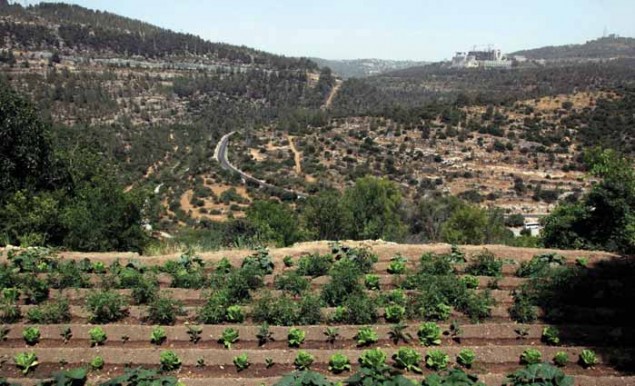 Overlooking the terraces at Sataf
Overlooking the terraces at Sataf
Photos: www.sassontiram.com
Growing up in New York in the 1950s, my connection with the Jewish National Fund (Keren Kayemet L’Yisrael) was a little blueand- white tin box with a Star of David in which we placed small change from time to time to help plant trees in Israel. Few people realize that JNF’s work goes way beyond its 110-year effort to reforest the land (over 240 million trees have been planted to date). One of the very lovely sites JNF has developed and maintains is known as Sataf, just a few minutes from the hustle and bustle of downtown Jerusalem.
Biblical verses describing the natural resources of the Land of Israel come alive in Sataf, from the list of the Seven Species of Israel in Devarim 8:8 (“a land of wheat and barley, grapes and figs and pomegranates, a land of olive oil and honey”) to the magnificent metaphors of Shir HaShirim, the Song of Songs, to the many references to the land in other parts of Nevi’im. At the site, trails to two natural springs, through olive groves, vineyards and cultivated terraces, take one back to a “corner of hidden beauty, where time seems to have stood still.”*
More than 4,000 years ago, inhabitants of the Land of Israel discovered that they could turn hillsides into flourishing gardens by terracing. In the Israelite period, our ancestors who inherited the land found that in many instances the valleys, which were the best farming lands, were already being worked on by the local inhabitants. Joshua challenged the tribes who lived in Judea and Samaria to clear the rocky sides of the hills and build terraces for planting (Joshua 17:15-18). They did so, creating flat land for agriculture on the slopes of the hills.
Many of the rocks that were cleared from the slopes were then used to build watchtowers to guard the crops (Isaiah 5). “My beloved has a vineyard on a fruitful hill. He broke the ground, cleared it of stones, and planted it with choice vines. He built a watchtower inside it . . . ” In Sataf, the gardens were irrigated by natural rainfall, which flowed from level to level, and by two springs which exist to this day, providing sustenance to crops on the levels below.
Sataf has a number of marked trails that afford wonderful opportunities to observe ancient methods of terrace farming. There are three parking areas at the site: the upper level, middle level, and lower level parking lots. A road from the Sataf Junction leads to the upper parking lot where you will find a small visitors center, an informa-tion booth, a snack bar and restrooms. Make use of the shaded picnic tables overlooking the hills of Mount Eitan with Jerusalem’s Ein Kerem neighborhood and the Hadassah Hospital clearly visible across the valley. Browse the various display boards telling the history and botany of the area, and make sure to pick up a map at the information booth.
Those fluent in Hebrew can enjoy reading a wonderful pamphlet called Sataf Biblical Orchard, which describes many of the trees in Sataf, and includes Biblical references and midrashim for each.
I suggest you park in the upper parking lot so you can enjoy the beautiful view. Follow the “green trail” (marked with a green stripe painted on rocks along the trail) as it winds its way down the hill, passing through lush groves and vegetation on its way to the spring located on the middle level. Another option is to park in the center parking lot while you explore the springs.
The Sataf Spring (Ein Sataf ) is the main spring in the area. Periodically during the past 2,000 years, small villages were built above the spring, taking advantage of the constant water source. Make sure to bring a flashlight so that you can descend from the terrace above the spring to explore the man-made cave, where the water emerges from the rocks. Small children will have fun and not even have to bend down as they enter the tunnel our ancestors cut into the rock to channel the water to a large storage pool. Nearby is the second spring, Ein Bechora. You can also enter this cave without stooping as much. Look for the stalactites and stalagmites!
After you have explored and enjoyed the area of the springs, you can ascend by trail to the upper parking lot where you began your visit, or continue to descend via the green trail to the lower parking lot, located on the Nahal Sorek Road connecting Ein Kerem and Bar Giora. For the latter option, you will have to have left a vehicle in the lower-level parking area.
The Tanach frequently refers to the physical beauty of the Land of Israel. While wandering in the desert, the Jewish people were assured by God that He was bringing us to “a good Land, a Land with springs and streams and fountains that spring forth from the plains and the hills” (Devarim 8:7). Imagine what this imagery must have meant to people who for forty years only knew the desert.
The fall season is a wonderful time to visit Sataf. Hike its trails, admire its natural beauty, take lots of pictures, eat your sandwiches at the picnic tables . . . and thank God for our eternal connection with the magnificent Land that He has given us.
Peter Abelow is a licensed tour guide and the associate director of Keshet: The Center for Educational Tourism in Israel. Keshet specializes in creating and running inspiring family and group tours that make Israel come alive “Jewishly.” He can be reached at 011.972.2.671.3518 or at peter@keshetisrael.co.il. Special thanks to JNF for graciously providing materials and assistance in the preparation of this article.
